






A 50th anniversary is the perfect time to look forward
Edith Heard
EMBL was created in 1974 – 10 years after our sister organisation EMBO was founded – when 10 countries saw the need for a Europe-based molecular biology research laboratory and signed an agreement to turn the idea into reality. Half a century later, EMBL has 29 member states (and counting). The initial vision of why this organisation was so important to create, shines on! In fact, by constantly exploring new ideas, embracing new cultures, and finding new ways to think about life science – thanks to our constant flow of young people – EMBL is more impactful than ever.
From the very beginning, the special symbiosis between scientists at EMBL and our member states, as well as EMBL’s ability to be at the forefront of molecular life sciences and attract people from all over the world, has meant that European countries continue to provide their support and to prize this organisation as a flagship of European life sciences research, service, and training.
Together, we have built labs engaging in transformative, fundamental research. We have fostered a culture of thinking outside the box to push technologies beyond their initial purpose. We have nurtured discoverydriven research and then transformed discoveries into applications. We have trained hundreds of scientists who have had influence far and wide, sharing expertise and EMBL’s collaborative spirit and guiding principles.
And this support has led to innovative concepts and shareable technologies.
This year, EMBL celebrates 50 years of delivering research, technology, innovation, and training that benefit not just Europe, but the world: EMBL’s role in providing infrastructures, democratising science, and helping people work together has been absolutely invaluable. We are using this anniversary to highlight advances in life sciences that have engaged our many collaborators, supporters, alumni, donors, and visitors to our six sites, propelling the whole of European science forward.
EMBL has had many achievements, in many areas that have formed the basis of science today. Here are just a few. In the early 1990s, researchers from EMBL Heidelberg realised that sequencing would be transformative for biology, but only as long as we had a place to archive, analyse, and annotate these sequences, and, most importantly, make them publicly available. That was the birth of EMBL’s UK site – the European Bioinformatics Institute (EMBL-EBI).
In 2017, Jacques Dubochet, together with others, was awarded the chemistry Nobel Prize for the technique used to freeze samples in a specific way for study







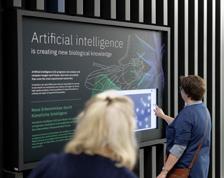
by cryo-electron microscopy. Today, we use this technology to view, in unprecedented detail, cells and the molecular machines they contain.
Following in the footsteps of another pair of Nobel Prize winners from EMBL, Christiane Nüsslein-Volhard and Eric Wieschaus, who provided fundamental insights into how genes control embryo development, EMBL scientists today are studying how exposure of fruit flies to different environments and pollutants, such as pesticides, affects gene expression and development, as well as behaviour and fertility.
Thanks to its collaborative and creative science, EMBL continues to pioneer, and our young scientists of today will be the giants of tomorrow!
that knowledge to help find solutions for the human and planetary challenges we face. This is at the heart of our latest research programme ‘Molecules to Ecosystems’.
Today, we are applying cutting-edge technologies to explore life at the molecular level in the context of different ecosystems and to build new models from the engineering of vascularised human tissues, to the culturing of communities of microbes that coexist in changing environments. We are training the next generation of scientists and industry leaders and propelling discoveries and innovations in this new era, both in the science we do, and the way we do it through open science and our environmental initiatives.
As the world around us continues to change, EMBL leads the way into a new era for life sciences.
We now have the tools and technologies to make important, relevant contributions to exploring and understanding life in its natural context and to apply
Most important of all, this special anniversary year is a moment to celebrate the people who have worked at EMBL. I am very grateful to all of our staff – past and present – for the unique scientific ecosystem that EMBL represents. As you look through this commemorative publication, I hope you will see how our work draws on EMBL’s past, as well as the beauty of EMBL science that shines a light on the future.





“On EMBL’s anniversary, and with EMBL being its people, I wish everyone ingenuity and brilliance to overcome any challenges, and introspective opportunities such as this one to collectively reflect upon and celebrate our achievements and successes.”
— Renato Alves, Senior Bioinformatics Community Manager, EMBL Data Science Centre

“EMBL is a science paradise. I was lucky to spend recently two years at EMBL Heidelberg as a visitor. I have enjoyed the spirit of collaboration, the happiness of doing science, the respect of each other’s work and the willingness to help. I came back rejuvenated!”
— Pascale Cossart, Professor “de Classe Exceptionnelle”, Institut Pasteur, Paris (EMBL Visiting Scientist 2022–2023)

“It’s been great to interact with innovative researchers from all over the world that make up EMBL’s scientific community. I have broadened my research horizons and enhanced my scientific research long term. With EMBL’s renowned expertise in genomics, I think this was the right place for me to be!”
– Virginia Fasoulaki, PhD Student at Institute of Molecular Biology and Biotechnology (IMBB), FORTH, Greece; Scientific Visitor at EMBL 2022

“EMBL is a dream come true for a young researcher in love with molecular biology. I consider myself extremely lucky to have experienced the unmatchable culture and working ethos of the Laboratory, the attitude of openness and sharing, the atmosphere of excitement and creativity, the ability to learn new things every single day, the possibility to be inspired by so many talented and passionate people, and also to participate in a cosmopolitan and diverse community of scientists. I am grateful for everything and I wish EMBL to remain the cherished flagship of molecular biology in Europe for many, many decades to come!”
— Niovi Santama, postdoc in the Lamond Group 1993–1996; now Professor, Molecular Biology & Biochemistry Lab at University of Cyprus

“We are pleased to collaborate with EMBL, which represents some of the most cutting-edge life sciences research in Europe. Together we can boost our shared vision of utilising life science innovation to create an impact for people and society.”
– Markus Herrgård, Chief Technology Officer, BioInnovation Institute Foundation (BII)

— Alexander van Oudenaarden, Group Leader, Hubrecht Institute, Utrecht, The Netherlands

“EMBL’s research, services, and resources are absolutely essential to Europe’s pioneering and leading role in both experimental and computational biology.”


It’s EMBL’s high standards, scientific excellence, and wonderful facilities that make me want to continue my connection with EMBL. Also, I really enjoy going to EMBL conferences.
— Wendy Bickmore, Director of the MRC Human Genetics Unit
EMBL has always been a jewel in the crown of European biomedical science and we need it now more than ever.
— Hans Clevers, Hubrecht Institute and Utrecht University


Being at EMBL was an extraordinary experience. It’s a paradise for science. This is partly because of the many resources which are available, but also because the people at EMBL are so passionate about their science.
— Lola Ledesma, Centro de Biologia, Molecular Severo Ochoa

I believe the interactive and collaborative culture between industry and EMBL will continue to be a key component that will grow further. Complex challenges in our society can only be tackled in close collaboration and by bringing together experts of multiple fields. At the same time, EMBL’s new programme will open up the possibility to interact with a different ecosystem of industries and companies.
– Jürgen Bauer, Deputy Managing Director, EMBLEM



In my view, what’s particularly great is that EMBL offers the prospect of engaging in pioneering research, delving into interdisciplinary collaboration, and contributing substantively to the realm of molecular biology and beyond. It’s a place where world-class research flourishes, exceptional colleagues abound, and the potential for profound contributions to the scientific community thrives – making EMBL an environment where professional dreams can truly take flight.
— Sihyun Sung, Staff Scientist at EMBL Grenoble

At EMBL you have the chance to meet and work together with people from so many different backgrounds, cultures, skills, and experiences, and I believe this is a fantastic opportunity to bring out the best in everybody and to grow and develop both professionally and personally.
– Gerald Pfister, Head of the Flow Cytometry Facility at EMBL Rome

I fell in love with EMBL during my Master’s thesis project. Although it was during COVID times, I was amazed by how stimulating and friendly the EMBL environment was... It’s a great international environment of people who all left their home countries and are excited about research, so I feel at home here.
– Zuzana Koskova, Predoctoral Fellow, EMBL Heidelberg
The roots of bioinformatics at EMBL lie in the world’s first nucleotide sequence database, the EMBL Nucleotide Sequence Data Library (now known as the European Nucleotide Archive), established in 1980 at EMBL Heidelberg. This database of nucleotide sequences generated and submitted by the research community has, from the very beginning, provided researchers with open access to nucleotide data without restrictions. This approach facilitated a paradigm shift in how research data were shared and used across the scientific community. Along with partners in the USA and Japan, EMBL-EBI is today a key part of the International Nucleotide Sequence Database Consortium (INSDC).
The Data Library merged into the Biocomputing programme at EMBL, founded in 1986. In 1992, the EMBL Council voted to establish EMBL’s European Bioinformatics Institute (EMBL-EBI) at the Wellcome Trust Genome Campus in Hinxton, UK. In its three decades of existence, EMBL-EBI has played a major part in the bioinformatics revolution. Today, it provides a world-leading and comprehensive range of molecular biology databases and operates a training programme globally.
Over the last few decades, EMBL-EBI’s expanding portfolio of resources has reflected the growing

Wolfgang Huber, Jan Korbel, Jo McEntyre, Oliver Stegle discipline of bioinformatics and increasingly datadriven life sciences. These have included: UniProt, the knowledge base of protein information – now covering over 200,000,000 known and predicted proteins, and the Ensembl Project, originally focussed on data emerging from the Human Genome Project in late 1990s. Today, Ensembl enables researchers to browse not only the reference human genome but also genomes across nearly every branch of the evolutionary tree, allowing sophisticated comparative genomics and analysis of downstream effects of genetic variations. EMBL-EBI’s Protein Data Bank in Europe (PDBe), set up in 1996, was one of its founding members of the worldwide Protein Data Bank (wwPDB) in 2003, growing from the original Protein Data Bank, which has been in operation since 1971.
EMBL-EBI also collects gene expression data, proteomics, metabolomics and other curated data collections such as protein families, molecular interactions, pathways and ontologies, and the scientific literature. Most recently, in 2019, the BioImage Archive was launched, opening new opportunities to combine image data with data in fields such as spatial transcriptomics and proteomics.
In 2024, the EMBL-EBI websites are receiving over 100 million requests for data per day. The data are used in many ways – from straightforward information



look-ups by biologists and non-experts, to supporting sophisticated algorithm development by computational biologists, to innovative product development in industry. Collecting the data and making it as easy as possible to reuse enables researchers to rapidly build thematic platforms such as the COVID-19 Data Portal, which was developed in a matter of weeks in response to the pandemic to enable effective SARS-CoV-2 data sharing, accelerating research and supporting the development of diagnostics, therapeutics, and effective vaccines.
In 2013, EMBL co-initiated the Pan-Cancer Analysis of Whole Genomes (PCAWG) project, a pioneering study for cancer genome and transcriptome data sharing, drawing participation from a global consortium of researchers. The project undertook a detailed analysis of cancer genome sequences from 2,800 patients, resulting in important insights regarding tumour evolution and progression. The project also addressed the ethical considerations surrounding patient data sharing, setting a precedent for future international studies.
EMBL-EBI initiatives are also playing a major role in understanding and conserving the rich biodiversity of our planet, through projects such as the Darwin Tree of Life (DToL) initiative, part of the Earth Biogenome Project, the African BioGenome Project (AfricaBP), and the Global Microbial Gene Catalog (GMGC).
Big data need reusable and open software and algorithms to analyse and interpret them. EMBL has played an organising and structuring role here, supporting developer platforms and code repositories such as Bioconductor (founded in 2001) to bring interoperability and sustainability into these distributed and diverse efforts.
With growing data also comes the need for standardisation, ensuring that data remain easily interpretable and reusable by scientists throughout the world. Here, EMBL-EBI has promoted standards that ensure data are not only openly available, but also Findable, Accessible, Interoperable, and Reusable (FAIR). It has also helped in developing international standards and guidelines for sharing, annotating, and archiving biological information, thus helping maintain the integrity and reliability of biological databases.
Perhaps one of the most exciting revolutions in biological data analysis has been the advent of AI-based methods. AlphaFold – an AI-powered system that can accurately predict millions of protein structures was developed by Google DeepMind and required the publicly available protein structure data in PDBe for training. In 2021, EMBL-EBI and Google DeepMind together released the AlphaFold Protein Structure Database – an open platform where anyone can search, analyse, and download an AlphaFold prediction for every single known protein in UniProt. Other than this, in recent years, EMBL scientists have been actively developing and applying AI methods in molecular biology across a variety of fields and applications.
Together with our world-class research and open data resources, it is exciting to think about what EMBL’s impact on bioinformatics is going to be in the next 50 years, especially in the face of the AI revolution, whether at the level of a single cell or an entire ecosystem. As we look towards the future, it is clear that EMBL is going to continue its leadership, not only in housing the world’s biological data resources, but also in enabling its widespread and responsible use.
How EMBL’s PhD programme is shaping tomorrow’s scientific leaders
Anne Ephrussi, Matthias Hentze, Monika Lachner
Since its establishment in 1974, one of EMBL’s key missions has been providing in-depth, relevant training to the scientific community in Europe and beyond. EMBL’s 1982 programme laid down the foundational plans for a PhD programme, into which the first fellows were recruited in 1983. In 1997, EMBL’s council made the historic decision to allow EMBL to grant PhD degrees; this authorisation became the basis for joint PhD degrees with numerous universities across Europe, fundamentally changing the way EMBL interacted with universities in its member states.
Almost from the beginning, EMBL stood apart in the way it structured its PhD programme, with the goal
of fostering early scientific independence combined with dedicated mentorship and an interdisciplinary approach. PhD students received mentorship and scientific advice not just from their thesis supervisors, but from a purposefully selected panel of scientists both from within and outside EMBL. In this way, EMBL’s PhD training became a role model and a template for PhD training in the life sciences across Europe, a process that it actively supported and continues to support.
One turning point in the history of EMBL’s PhD programme was the introduction of predoc courses. Initially held in thematic, discontinuous blocks spread over the first year after students joined, in the early



1990s, these courses were integrated thematically and structured as a single block of eight weeks of intensive training, within the first few months of most students in a cohort having just joined. What the organisers didn’t realise at the time was that it would radically change the PhD programme, as well as EMBL as a whole.
This is because the experiences shared by the predoctoral fellows during the course leads them to form particularly strong connections and bonds with one another and allows them to build a network they can rely on for the rest of their time at EMBL, also opening up unexpected avenues for cooperation in their projects. Today, the predocs remain one of the best-connected groups within the EMBL community, and through them, seeds of scientific collaboration have sprouted throughout the institute, ultimately bringing together EMBL as a whole.
Another brainchild of this connectedness is the annual EMBL International PhD symposium, a student-led and -organised initiative, first held in October 2000. The PhD symposium is an opportunity for early career researchers from all over the scientific world to meet and discuss their science, as well as listen to multidisciplinary lectures by top-level speakers. One of the highlights of the event is networking between PhD students and established scientists, which carries forward and enriches their work beyond the symposium.
The goal of the PhD programme is not just to encourage excellent scientific outputs from the fellows, but also to nurture their scientific growth and help their future career development. In the last five years, EMBL has invested significantly in this area, building a comprehensive programme to support career decisions and aspirations. This is particularly important in light of the fact that in the last few
decades, the research landscape has changed significantly in Europe and globally. While the number of academic positions has not kept pace with the growth in the number of PhD graduates, many new opportunities are available today that weren’t before.
In 2023, EMBL conducted a study that analysed the career outcomes for 2,284 early-career researchers who completed PhDs or postdoctoral training at EMBL between 1997 and 2020. It shows that while the majority of fellows continued in academic career paths (~55%), many were equally successful in nonacademic science-associated careers. The study also shows EMBL’s commitment to evidence-based training and its tradition of using hard data to design its training portfolio.




As we celebrate EMBL’s 50th anniversary and head into the next phase, it is clear that we have a strong PhD programme that is ready to address the challenges of the future, one that adapts to quickly changing fields and scientific landscapes, especially in the context of emerging fields such as the use of AI in biology. The educational background of PhD candidates as well as their future aspirations have also evolved and changed based on the research EMBL is doing. For example, the organisation’s present focus on interdisciplinarity encourages students from a wide range of backgrounds, such as physics, engineering, and mathematics, to join. Our vision for the next 50 years is to evolve the programme in a way that continues to ensure we are training our students for the future.
Doctoral training is only one of the many aspects of EMBL’s rich and thriving training programme, which includes courses, conferences, visiting fellowships, workshops, and much more. To read more about our training-related offerings, visit our website.
50 years of imaging developments at EMBL Jan Ellenberg, Matthew Hartley, Christoph Müller
In the late 1970s, John Kendrew, EMBL’s first Director General, hired biophysicist Jacques Dubochet to set up methods for carrying out electron microscopy at very, very low temperatures. Dubochet would go on to win the Nobel Prize in Chemistry in 2017 for the development of cryo-electron microscopy (cryo-EM). However, this is only one of many examples where technological advancement has progressed hand in hand with research at EMBL to push the field of bioimaging across new frontiers.
The path to Dubochet’s discovery had already been paved by the likes of Kevin Leonard, who joined EMBL in 1975 and pioneered the use of electron microscopy in structural biology. In the 1980s, one of the first to realise cryo-EM’s potential was Steve Fuller, who, through his work on virus structures, was a key driving force for cryo-EM development and application of computational image processing methods in biology.
Microscopy Core Facility (EMCF) and the group of Yannick Schwab.
Today, these advanced electron microscopy techniques continue to be used by EMBL scientists to answer fundamental biological questions, as well as provided as a service via its core facilities to researchers across the world.


In the early 2000s, EMBL hired its first experts in cryo-electron tomography (cryo-ET) – a method somewhat akin to a CT-scan for cells – Achilleas Frangakis, John Briggs, and later, Martin Beck. Another electron microscopy method, volume EM (vEM), in which electron microscopy techniques are applied to ‘large’ volumes to generate a three-dimensional view of a cell, tissue, or an entire organism, was first introduced at EMBL in the early 2010s by the Electron

In parallel to developments in electron microscopy, EMBL has also been a pioneer for advances in light microscopy. Following major contributions to introducing confocal microscopy to biological research by Ernst Stelzer in the 1980s, allowing us to image cells in three dimensions, a major challenge in optical microscopy remained the diffraction limit, which imposes a physical limit on the resolution achievable by light microscopes. However, by the 1990s, scientists had already begun coming up with ingenious methods to get around this obstacle. One of the leading figures in this area was EMBL alumnus
Image: Newly discovered neuroid cells communicate with digestive cells in the feeding chamber of a sponge. This SEM image was inverted and recoloured for the 2019 Annual report cover.
Credit: Giulia Mizzon, Jacob Musser, Constantin Pape, Nicole Schieber/EMBL (Schwab, Arendt, and Kreshuk Groups) Edited by the Creative team/EMBL

and later Nobel awardee Stefan Hell, who would go on to develop super-resolution microscopy techniques such as stimulated emission depletion (STED) and MINFLUX. Another pioneering development to come out of EMBL was light sheet microscopy – a technique that allows scientists to image and monitor live biological samples in three dimensions. The key contributors here included Ernst Steltzer, Jan Ellenberg, and Lars Hufnagel. Scientists at EMBL today continue to experiment with the limits of light microscopy, using it in new and innovative ways to obtain novel biological insights.
Advanced imaging techniques produce huge datasets, which must be properly analysed, shared, and archived.
Here, a key role has been played by EMBL-EBI, which, in 2019, launched the BioImage Archive, a large-scale, free, and centralised public data resource to host imaging data. The Archive builds on a long foundation of EMBL-hosted public archives for molecular and imaging data, which includes EMDB (the Electron Microscopy Databank, 2003) and EMPIAR (Electron Microscopy Public Image Archive, 2013). EMBL research and service groups have also been
instrumental in finding new ways of making such data easily accessible, analysable, and visualisable by researchers worldwide.
Across all these developments, EMBL’s key strength has been its ability to bring together scientists or engineers interested in technology development and biologists interested in answering fundamental questions about how life works. EMBL has also helped expand access to advanced imaging technologies to the entire scientific community in Europe and beyond, through its core facilities, its support for infrastructures like Euro-BioImaging, and its newly established EMBL Imaging Centre, which brings together technology development, industry collaboration, and service provision under one roof. EMBL has also been at the forefront of providing training in high-end imaging techniques through a large portfolio of workshops, courses, and conferences.


It is exciting to speculate about the new roads that we will be travelling in bioimaging in the next fifty years and beyond. One area in which we are already seeing rapid advances is in the integration of imaging with omics approaches, such as the new fields of spatial transcriptomics and spatial proteomics. We are also moving from an era of primarily focusing our imaging on model organisms to imaging diverse samples, including those collected from the environment. This, along with integrating light or electron imaging with other techniques like X-ray imaging and nano-beam imaging, can help us obtain unprecedented new insights into the inner workings of living systems.
Celebrating 50 years of EMBL’s international engagement across Europe and beyond

“Over the last five decades, EMBL has led the integration of life sciences across Europe and beyond. Since 10 founding member states came together in 1974 to establish the laboratory, EMBL has grown to encompass 29 member states, working closely together to empower the delivery of the Laboratory’s missions for the benefit of our collective progress and well-being.”
– Plamena Markova, Head of International Relations, EMBL
“This is a truly impressive organisation. Access to this kind of infrastructure will mean a lot for the Estonian research community, and provide a great platform for career development under the best possible supervision. This partnership will also help us to build up our own system in Estonia, to welcome those researchers back at some point in the future.”
– Renno Veinthal, Deputy Secretary General for Research and Development, Higher Education, and Vocational Education and Training Policy, Estonia
“EMBL’s broad range of expertise, infrastructures, and capacities – in biology, high-performance computing, data analysis – can contribute to a broad range of current European research and innovation priorities. Access to these intergovernmental facilities is vital for European researchers and innovators.”
– Marc Lemaître, Director-General of the EC’s Directorate General for Research and Innovation
“[TREC] is an extraordinary, high-level research, training, and public engagement expedition. These kinds of endeavours demonstrate big ambition and an important vision for the future.”
– Raquel Yotti, Secretary General for Research at the Spanish Ministry for Science and Innovation
“We have been absolutely delighted with the quality of the research that is taking place across our Partner Laboratory Network, which is a direct consequence of the quality of the fellows that we have managed to recruit and the research partnership community that has been built up in Australia, all through our EMBL membership.”


– Ian Smith, Chair of EMBL Australia

“In joining the leading European research organisations in molecular biology, Latvia is fully integrating into the European biology and biomedical research ecosystem and fostering collaboration with leading experts and partners in biological and medical research and technology transfer.”
– Anda Čakša, Minister of Education and Science, Latvia
“Fostering exchanges with EMBL is a great opportunity for our research groups at CdF. Not only do we share common interests on a number of topics, but we have complementary expertise. Access to EMBL’s cutting-edge service facilities should immensely advance our research. We are very excited about the idea of exchanging students, engineers, and researchers within defined collaboration programs to work together on hot topics [...].”
– Nathalie Rouach, Collège de France (CdF), France





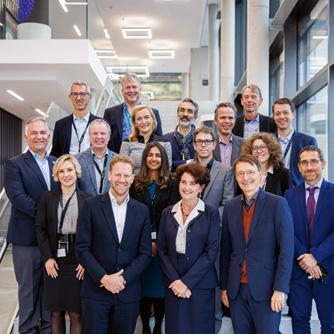






Kristina Djinovic Carugo, Julia Mahamid, Janet Thornton
The journey of structural biology in the last five decades has been one of continuous technological progress coupled with exciting biological insights. During this time, EMBL has been a world leader in the field, through innovative technological and methodological developments; biological discoveries; pioneering, developing, and hosting of databases used by millions of scientists worldwide; and state-of-the-art structural biology services.

In 1975, EMBL’s founders decided to establish sites in Hamburg and Grenoble, on campuses with sources of highenergy beams/ particles that could be used for structural biology experiments. Both EMBL Hamburg and Grenoble provide a rich environment for instrumentation engineers, scientists, and service specialists to collaborate and innovate.
Many of these developments have focused on a technique called macromolecular crystallography. Researchers studying the three-dimensional structure of a macromolecule (e.g. a protein) need to first isolate it in its purest form and induce it to form crystals, whose atomic structure can then be determined by bouncing X-rays off them. Over the
past two decades, EMBL researchers and engineers have developed and implemented an unprecedented degree of automation in macromolecular X-ray crystallography, neutron crystallography, SAXS, and lately for cryo-EM, in addition to pioneering new techniques and methods, which are offered as a service to scientists worldwide.
While macromolecular crystallography allows researchers to precisely determine the position of every atom in a protein or protein complex, researchers have also been perfecting techniques that allow us to ‘see’ large, complex macromolecular structures directly using advanced electron microscopy. In the early 1980s, EMBL Group Leader Jacques Dubochet’s team found a way to freeze biological samples while avoiding ice crystal formation, a breakthrough which led to the development of cryo-electron microscopy (cryo-EM), a method which allows large and flexible molecular machines that cannot be easily crystallised to be imaged. This work would bring Dubochet a Nobel Prize in 2017. A closely related method, cryo-electron tomography (cryo-ET), allows scientists to take snapshots of even more complex samples, including
Image: The human nuclear pore complex (NPC) is a doughnut-shaped molecular complex consisting of 30 different proteins arranged in ~1000 copies. It weighs 120 MDa, which on the cellular scale is enormous.
Credit: Agnieszka Obarska-Kosińska/EMBL and MPI of Biophysics
viruses or intact cells, along with all their internal components, which can later be reconstructed in 3D.
What macromolecular crystallography, cryo-EM, and cryo-ET have in common is their propensity to generate huge volumes of data, and an ever-increasing number of protein/macromolecular structures, which can be mined for insights. In 1971, the Protein Data Bank (PDB), was established as the central archive for experimentally determined macromolecular structure data. In 1999, EMBL-EBI researchers helped set up the PDBe (Protein Data Bank in Europe) in collaboration with the PDB in the USA to handle the increasing flood of protein structure data and to develop an extended structural knowledge base. The PDBe now operates as part of the worldwide Protein Data Bank (wwPDB) international collaboration.
In 2002, EMBL-EBI founded the Electron Microscopy Data Bank (EMDB), a public repository for cryo-EM maps and tomograms, followed by the Electron Microscopy Public Image Archive (EMPIAR) in 2014, a public resource for raw images underpinning 3D cryo-EM maps and tomograms. Similarly, the SASBDB is a fully searchable, curated repository of freely accessible and downloadable data related to small-angle scattering experiments. Such databases have been essential for the advancement of technology and standards, as well as transparency and validation efforts.
The 130,000 experimentally determined protein structures in the PDB played a critical role in one of the most exciting recent breakthroughs in structural biology – the AI-based protein structure prediction tool AlphaFold2. AlphaFold tackles a long-standing problem in structural biology – predicting a protein’s 3D structure given its sequence of amino acids. In 2021, DeepMind, the company which developed AlphaFold, partnered with EMBL-EBI to make the AlphaFold protein predictions freely and openly
available to the global scientific community through the AlphaFold database, which was later updated to include more than 200 million protein structures, covering almost every organism on Earth that has had its genome sequenced. The availability of a realm of reliable 3D models of proteins has, in turn, sparked a revolution in the design and execution of experimental projects across life science disciplines. Using such an array of structural biology tools, EMBL researchers have shed light on some of the most fundamental mechanisms in living systems. They have expanded our understanding of transcription and translation, DNA remodelling and chromatin structure, small-molecule transport across membranes, viral structures, replication, and assembly, the nuclear pore complex, and much more.
In addition to such seminal research, one of EMBL’s key roles in the last five decades has been democratising access to structural biology techniques and data, so that structural biology is no longer a field confined to structural biologists. As we head into the next fifty years, we expect this trend to continue.
Today, we are increasingly seeing structural biology across scales and in four dimensions, with future technological developments likely to improve both temporal and spatial resolution. We also expect to see more in situ structural biology, combined with biophysical and biochemical approaches, as well as further glimpses into the cell’s ‘dark matter’ –intrinsically disordered proteins, which do not have rigid 3D structures. Finally, we foresee a holistic structural biology approach in the future, where rather than deciphering one structure at a time, we will learn about ensembles of structures of the same molecular assembly, or even about multiple assemblies at once.

















Ewan Birney, Eileen Furlong, Arnaud Krebs
In the last few decades, the field of genomics has grown by leaps and bounds, and throughout this exponential revolution, EMBL has played a pivotal role, one it continues to expand on today.
One of the pioneers of the field was EMBL alumnus William Ansorge, whose group developed methods for fast and accurate DNA sequencing, as well as the first automated fluorescence DNA sequencing system for large genomics DNA. In the early 2000s, EMBL was also one of the first European research institutes to take advantage of the rapid technological progress in next-generation sequencing (NGS) methods, through its core facility GeneCore. Today, GeneCore provides advanced end-to-end support to users from across Europe in their genomics projects.
The growing number of DNA sequences in the 1970s and 1980s created a demand for computational support to deal with the resulting data deluge. In 1980, EMBL founded the EMBL Nucleotide Sequence Data Library, the first central depository of nucleotide sequence data in the world. Under Graham
Cameron’s leadership, this later developed into the EMBL-European Bioinformatics Institute (EMBL-EBI), established in 1994 in Hinxton, UK.
Since then, EMBL-EBI has developed and made available systematic annotations of genomes with flagship projects such as Ensembl, providing a roadmap for scientists to probe genome functions. Moreover, it has pioneered the development of repositories for scientists, promoting open data exchange within the scientific community. EMBL has also led the way in developing, validating, and distributing computational tools for genomics analyses.
These reference genome sequences, and their annotations, provide scientists with a roadmap to decipher how the genome functions. This has been the drive for generations of researchers in EMBL’s Genome Biology Unit who have asked important questions such as which parts of our genomes are transcribed into mRNA, and what mechanisms regulate genome activity. A key to understanding these processes at the scale of entire genomes

is to develop high-throughput methods and tools with computational approaches. For instance, the development and use of microarrays was pioneered by EMBL researchers, showing that large parts of eukaryotic genomes, even outside of genes, are transcribed into RNA. Work along these lines has also helped decipher the regulatory function of a particular type of non-genic transcripts – microRNAs. EMBL researchers have also made several seminal contributions in identifying and understanding the mode of action of molecular machines that regulate genome activity, such as transcription factors or chromatin modifiers, especially those involved in organismal development. They have also played an important role in mapping and elucidating the action of ‘cis-regulatory elements’ – the DNA switches that turn genes on and off.
Research at EMBL is highly interdisciplinary, and while genome function has been mapped using sequencing techniques, genome regulation processes have also been deciphered from a molecular perspective using structural methods, with multiple research groups providing key insights into the structure-function relationships of enzymes involved in genomic function, such as RNA polymerase II.
The study of genomes has also opened up exciting possibilities for improving human health and helping solve global challenges. One key area of progress has been the study of microbiomes – all
the microorganisms that inhabit a given environment and which can be studied by rapid DNA sequencing methods. EMBL researchers have investigated such ‘metagenomes’ in diverse contexts, yielding important insights.
In addition, the Pan-Cancer Analysis of Whole Genomes project has created a huge resource of primary cancer genomes, providing resources and impetus for research groups across the world to investigate genomic mechanisms involved in cancer. Large genomics databases, such as those maintained by EMBL-EBI, are also crucial for the progress of genomic medicine – the use of technologies like DNA sequencing to support healthcare. Finally, EMBL also plays a crucial role in empowering the scientific community by organising meetings, conferences, workshops, and courses around genomics.
As we head into the next 50 years of genomics, it is interesting to speculate on the future of the field. New strides are already being made in the areas of single-cell omics, spatial omics, and whole-organism genomics studies. Large-scale perturbations of the genome are giving researchers new and powerful tools for investigating genome function. And finally, we are seeing a revolution in the processing of genomes from environmental samples, leading not only to a better understanding of global biodiversity, but also a clearer picture of the effect of our changing climate and human endeavours.
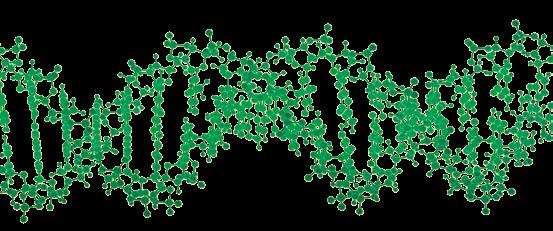




The last 50 years have been a time of continuous growth and discovery for EMBL. Here are just a few quick peeks inside this journey of excellence.
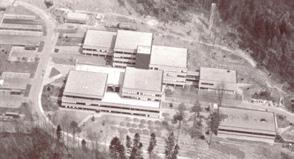


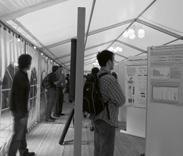


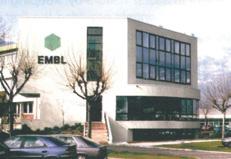


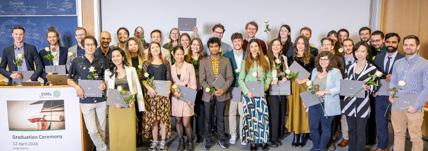


From top left: Graduating EMBL PhD students and graduation committee (2002), PhD graduation ceremony (2024), temporary tents set up to accommodate conference posters (2005), a poster session in the ATC (2020), Conference Officer Diah Yulianti in an empty auditorium during the COVID-19 pandemic (2021).

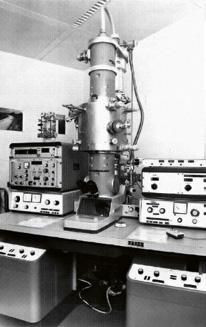
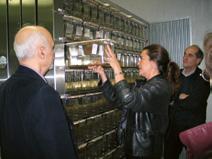




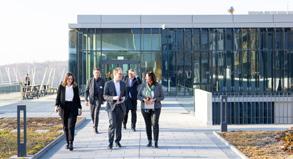

An early cryo-transmission electron microscope (1981), mouse facility in EMBL Rome (then EMBL Monterotondo)(2003), GSK-Cellzome celebrating its 20th anniversary (2023), a researcher working on the HTX platform (CrystalDirect harvester) at EMBL Grenoble (2023), the EMBL Hamburg P14 beamline installed with ARINAX micro-diffractometer (2021).






Peer Bork, Rob Finn, Nassos Typas, Michael Zimmermann, Maria Zimmermann-Kogadeeva
We live on a planet of microbes. Our microscopic fellow travellers colonised Earth long before oxygen appeared in its atmosphere and are the reason we have oxygen on this planet, every corner of which they now inhabit. Although microbes are usually unicellular organisms, they regularly form communities with members of the same and different species. EMBL scientists have been studying microbiomes – the collection of all the microbes in a specific habitat –for two decades, providing key insights into antimicrobial resistance, cancer, ocean biodiversity, and more.


human microbiome studies, playing a crucial role in the first EU microbiome grant in 2008 and hosting the founding of the International Human Microbiome Consortium (IHMC) in Heidelberg in the same year. Since the late 2010s, EMBL has also been leading experimental studies on the human microbiome, knowledge that has culminated in the establishment of a new Microbial Automation and Culturomics Core Facility in 2024.


Microbiome studies started at EMBL as early as 2003, with the first comparative study between habitats appearing in 2005. EMBL has been a pioneer in
In addition to the microbes that live on or in the human body, microbiomes from diverse habitats, such as our oceans or soil, have also been a key focus of study at EMBL. EMBL led the microbiome analysis in the Tara Oceans consortium, which published its first results in a special issue of the journal Science in
Image: In one recent study, EMBL researchers and colleagues analysed the effects of 144 antibiotics on common gut microbes, substantially improving our understanding of antibiotics’ effects.
Credit: Isabel Romero Calvo/EMBL
2015. Microbiome analysis also continues to be a key part of the ambitious Traversing European Coastlines (TREC) expedition, which began in 2023.
In the last decade, microbiome research has flourished in various groups across EMBL sites, strengthened by many close interactions and collaborations. EMBL scientists today apply computational, statistical and mathematical tools, as well as experimental approaches, such as high-throughput culturing and genetic screens, to better understand the associations of microbes with environmental factors, to establish microbial biomarkers, and to understand microbial functioning within ecosystems – from the human gut to European soils.
Recent studies from EMBL have shown, for example, how common drugs affect the gut microbiome and how these microbes sequester and chemically alter these drugs, influencing their positive and adverse effects. EMBL scientists are also studying how the gut microbiome can affect physiological processes such as immunity, reproduction, and cancer development. Insights gained from these studies could hold clues to better therapeutic and diagnostic strategies, as well as a richer understanding of how microbial species behave and interact in complex natural ecosystems, which could eventually help in designing interventions to improve human and planetary health.
At the same time, EMBL’s data services, such as the metagenomics data services (MGnify and SPIRE) and the European Nucleotide Archive not only advance EMBL’s own work but also enable microbiome research worldwide. Our computational groups have pioneered efforts to recover genomes from metagenomics datasets, spanning viruses, archaea, bacteria, and single-cell eukaryotes. For example, studies on the human gut and skin have provided unprecedented insights into the human
microbiome, yielding information on novel species and demonstrating the compositional variability of the microbiome at different body sites. Both studies involved extensive collaborations to generate the data, as well as to culture and sequence microbes to validate the computational findings.
More broadly, we have applied these computational approaches to tens of thousands of datasets collected across the world to identify millions of genomes associated with a wide range of host organisms and environments. Microbes have the highest functional capacity on this planet, with almost every commonly used molecular biology tool and many of the natural products used in medicines coming from them. Using these vast catalogues, and combining them with both experimental and data-mining-based approaches, EMBL researchers are trying to harness this huge capacity for novel functions, e.g. to aid the discovery of enzymes or the identification of biomarkers that may be indicators of diseases or environmental change.
EMBL continues to build on its strengths in this area, from taking microbiome research into the context of the environment with the TREC expedition to nurturing clinical collaborations to leverage microbiomes for improved human health, to developing new technologies to quantify and visualise microbial life in context, to establishing a new microbial automation facility to support cutting-edge experiments. The next 50 years of microbiome research will be exciting!




Since its founding in 1974, the European Molecular Biology Laboratory (EMBL) has sought to serve its member states by making fundamental discoveries in molecular biology, training researchers and research leaders, and developing new technologies that meet societal and scientific needs.
As Europe’s only intergovernmental organisation for life science research, EMBL strives to be at the forefront of modern biology and to build the foundations for future success. Through the EMBL Programme for 2022–2026 ‘Molecules to Ecosystems’, it intends to propel Europe into a new era of biological understanding, from the molecular building blocks of life through to the complexity of ecosystems. By thus studying life in context, we hope to gain new knowledge that is relevant to understanding life on Earth, and inform potential solutions for some of society’s biggest

challenges, such as the loss of biodiversity, antimicrobial resistance, pollution, climate change, food security, and emergent pathogens.

“The transversal themes were established in such a way so as to harness EMBL’s unique creative spirit and scientific freedom, whilst propelling a long-term vision through developing pan-EMBL collaborations across units and sites, utilising our strengths in research, services, and training, and renewed engagement with the scientific community.”
– Jessica Vamathevan, Head of Strategy
The programme expanded EMBL’s multidisciplinary and collaborative approach to its research, services, training, and operations. It introduced five new research themes, called ‘transversal themes’, all of which build on EMBL’s existing strengths and expertise in molecular biology to gain a mechanistic understanding of life in context. The new themes also aim to strengthen multidisciplinary research in the new areas and coordinate collaborative efforts within and between our member states and beyond. Additionally, the Data Science Centre was established to ensure the coordination of biodata activities across EMBL.
“With European collaborators, we are looking at improving the representation of disease trajectories and complex phenotypes, and understanding how interventions can mitigate genetic risk and improve health… It’s really exciting to do this in the context of the EMBL Programme as it amplifies our work and brings new possibilities for collaboration within EMBL and with member states.”
— Helen Parkinson, Co-chair, Human Ecosystems transversal theme

“Humans have been trying to understand infection for a very long time. While we have come a long way in our understanding of infectious disease, millions of people still die of communicable illnesses every year. We will focus on developing new tools for understanding and fighting infection and have a special emphasis on understanding the molecular mechanisms that underlie pathogenesis and antimicrobial resistance”
— Maria Bernabeu, Co-chair, Infection Biology transversal theme
“This is an incredibly exciting time for life science research, as perhaps for the first time, the theoretical frameworks for conceptual understanding of biological processes and our evergrowing experimental means to test predictions can be integrated in a truly meaningful, synergistic manner. Our Theory@ EMBL community is keen to leverage this.”

“By focusing further on microbial ecosystems, we can delve into the secret lives of microbes – what functions they encode and how these help them survey the environment, interact with each other, and live together in diverse, complex communities. Ultimately, we want to understand how the balance in these versatile communities impacts human health.”
– Nassos Typas, Co-chair, Microbial Ecosystems transversal theme
— Vikas Trivedi, Co-chair, Theory@EMBL transversal theme

“The Planetary Biology research theme is, in many ways, a completely revolutionary way to think about molecular biology and how it can help us understand our planet and the challenges it is currently facing. What’s more, we are envisioning using molecular biology approaches to devise potential solutions to some of the huge environmental issues of today, which is one of the most exciting ideas we have ever come across.”
– Detlev Arendt, Co-chair, Planetary Biology transversal theme



“The Molecules to Ecosystems Programme builds on EMBL’s strong and successful prior research and services…Data Sciences is of course not a completely new topic to EMBL – our current objective is to bring together, connect, and significantly strengthen existing activities, at the same time as adding new activities on top to make data sciences at EMBL much more effective.”
– Jan Korbel, Head, Data Science Centre

Tabea Rauscher
Today, the EMBL hexagonal logo with its 61 dots is a recognisable symbol across the scientific world in Europe. But what is it supposed to represent? Where did it come from? Why is one of the spots red?
It seems that the first use of the EMBL logo, though not quite as we know it, was the cover of the 1982 Annual Report. There were 217 dots. Before 1982, a sketch of the Heidelberg laboratory was sometimes used as a symbol for EMBL. The Laboratory’s shape, still recognisable today, appeared on leaflets and letter headings.
The initial design of this logo has been claimed by or attributed to several individuals. It was commissioned by Lennart Philipson, the second Director General of EMBL, and a microbiologist who specialised in respiratory viruses. One of the viruses he studied was the adenovirus.
When Konrad Müller, then Head of Human Resources, asked Lennart Philipson for a logo for EMBL, Philipson therefore naturally thought of the adenovirus. The virus’s hexagonal shape could represent all the laboratories in Europe, with the red spot being EMBL, now fully integrated in the European map. The location of the red spot was close to its position on a (very) schematic European chart.
But there’s also a different possible interpretation of the red and green. David Meyer, a group leader at the time, worked with Müller to turn Philipson’s idea into a usable logo. He remembers the green being used to stand for thought, and the red being the sparks of discovery that EMBL would bring.





For the first few years of EMBL’s existence, a schematic of the Heidelberg campus building was used for identifying purposes.
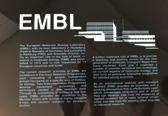
A schematic with 217 dots, based on the adenovirus structure, starts being used.

Image mark seen alongside the wordmark
The image mark as we now know is first seen with 61 dots.


EMBL sites each had a variation of the image mark designed to represent the work done at those locations.





The logo (word and image mark) lock-up as we now use is established.
The One EMBL visual framework is implemented, allowing the EMBL identity to be clearly recognised and used across all sites.








EMBL prospect member state
Serbia
EMBL member states and associate member states
Austria | Belgium | Croatia | Czech Republic | Denmark | Estonia
Finland | France | Germany | Greece | Hungary | Iceland
Ireland | Israel | Italy | Latvia | Lithuania | Luxembourg | Malta
Montenegro | Netherlands | Norway | Poland | Portugal | Slovakia
Spain | Sweden | Switzerland | United Kingdom | Australia
Publisher: EMBL
Publication Date: 2024
Editor: Shreya Ghosh/EMBL
Layout: Holly Joynes/EMBL
Publication coordinator: Haipeng Zhou/EMBL
Art direction: Tabea Rauscher/EMBL
Additional consultations and input: EMBL Communications, Archive, Strategy, and International Relations teams.
Image credits:
Images without direct credits are taken from the EMBL Institutional Publications collection, EMBL Archive. Photographs were from personal collections or taken on behalf of EMBL by: Montserrat Coll Lladó, Massimo Del Prete, Jeff Dowling, Stuart Ingham, Kinga Lubowiecka, Marietta Schupp, Carrie Tang, and/or the EMBL Photolab.
Background images, and embedded illustrations created by Karen Arnott/EMBL-EBI, Isabel Romero Calvo/EMBL, and the EMBL Creative Team.
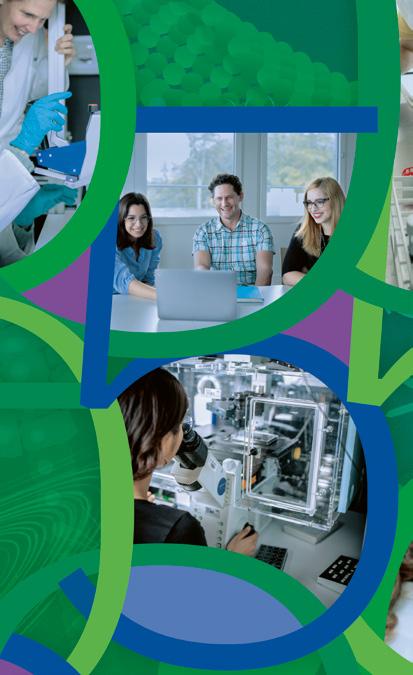
Follow us: +49 6221 3870 www.embl.org info@embl.org